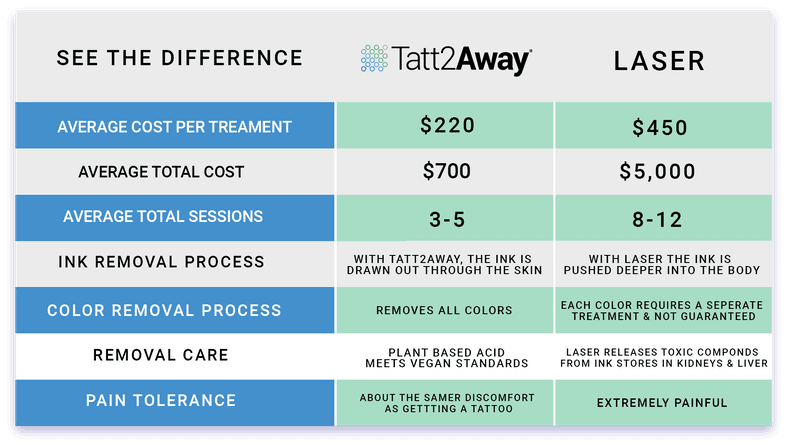Are You Considering Getting Laser Tattoo Removal?
Any discussion of tattoo removal options must begin with understanding how laser tattoo removal works. Tattoos are older than written history, but tattoo removal was limited to excision or abrasion until the early 1980s. The application of Q-switched laser energy in pulses lasting nanoseconds or less was revolutionary for tattoo removal. It allowed, for the first time, the targeted destruction of tattoo pigment without significant damage to the surrounding tissue. Until recently, laser was the standard of care in tattoo removal.
People who have experienced laser tattoo removal first-hand, or understand the science behind it, will tell you that it’s not a perfect solution. The problem of removing or altering unwanted tattoos is a stubborn one. Laser is not the magic wand of tattoo removal, for a number of reasons. Drawbacks of laser treatment include significant pain, high cost, numerous sessions, and damage to the skin and hair in the treated area.
How do lasers work to remove tattoos?
From a medical perspective, tattoos are thin masses of scar tissue in the dermis layer of your skin that contain coloured pigments. Your skin is slightly translucent, which allows you to see the ink trapped beneath the surface. Lasers remove tattoos by destroying the particles of pigment and driving them out of the scar tissue that holds them in place.
By its nature, laser has a number of limitations to its effectiveness. Foremost is the wavelengths of light absorbed by different ink pigments. For example, simple black ink typically absorbs laser energy very well and clears from the skin easily. But if the ink used by the tattoo artist was a blend, you may find some of the ink clears while others stay behind. Laser technicians refer to these as “stubborn colours.” Depending on the frequency of the lasers used, colours such as blues, greens, yellows, and purples are notoriously difficult for laser to remove. White pigments are nearly impossible for laser to remove, because they reflect more light than they absorb.
Where does the ink go after laser tattoo removal?
Once the ink particles are broken down and pushed deeper into the body by laser treatments, the body attempts to remove them in the same way it handles other waste. The particles are filtered through the lymphatic system, and some are expelled as part of faecal matter, urination, and even sweat. However, this is only part of the truth.
The effects of laser energy on tattoo pigment are very difficult to study. The variety of inks used in tattooing range from high-end acrylics formulated for professional artists to improvised materials used by amateurs. Even things like ballpoint pen inks, charcoal, and DIY mixtures are often used in tattoos. As long as artists and amateurs mix their own pigments, the variations are practically unlimited.
It is believed that, in general, ink that forms good tattoos does so in part because the pigment particles are large and easy to trap in scar tissue.
It is not understood what happens to those particles when they are broken down by laser treatments.
Many inks used by artists contain ingredients that are known to be toxic in different forms. Heavy metals such as cadmium and even lead are surprisingly common in the industry. It should be noted that as far as we know, these pigments are safe to use in tattooing. But once they are exposed to laser energy and pushed into your lymphatic system, the compounds change in ways that are not yet understood. These toxic compounds tend to settle in kidney tissue, lymph nodes, and other places throughout the body. The effects they have on your health are unknown at this time.
Laser Removal Alternatives
With these drawbacks, it’s no surprise that people continue to seek alternatives to laser tattoo removal. The most promising new way to remove tattoos is called Trans-Epidermal Pigment Release, a patented technique trademarked under the name Tatt2Away.
Tatt2Away solves many of the problems laser tattoo removal can’t address.
Because it is a non-laser removal method, Tatt2Away removes all colours equally well. There are no more “stubborn colours” to worry about. Tatt2Away is less painful than laser and requires fewer sessions for complete removal. Up to 35% of the tattoo is removed in the first session alone.
Prices reflective of the US:

Perhaps the biggest advantage over laser removal is that Tatt2Away doesn’t break down the pigments and push them deeper. Instead, the old ink is drawn out of the skin directly. The large pigment particles stay intact and are simply gone. This means there’s no need to worry about the toxic compounds breaking down and settling in your organs and tissues.
The “magic wand” tattoo removal treatment is still undiscovered, but until then, Tatt2Away is the best alternative to laser. If you’re considering which option to choose, you may want to know more about the differences between Tatt2Away and laser. You can also schedule a free consultation with your local Tatt2Away centre to ask all your questions over the phone or in person.
Should You Consider Laser Tattoo Removal? was originally published in Tatt2Away on Medium, where people are continuing the conversation by highlighting and responding to this story.

